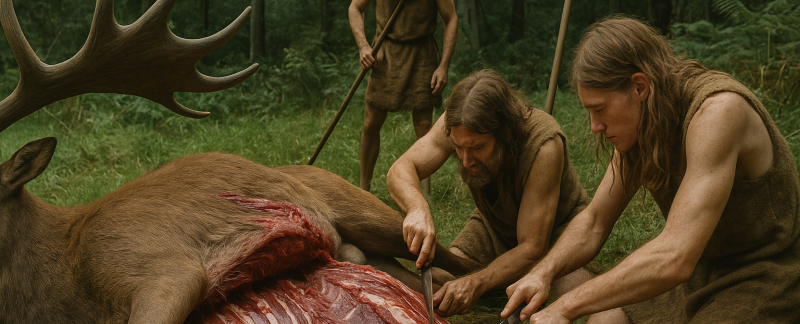Mesolithic Ireland is such a fascinating part of history, stretching from 8000 BC to 4000 BC, right after the Ice Age. Basically, Mesolithic Ireland is known as the Middle Stone Age, when the very first humans showed up in Ireland. As the ice melted, Mesolithic Ireland opened up, making it possible for small groups to move in and settle.
So, they camped near rivers, lakes, and the coast, adjusting to the changing environment and seasons in Mesolithic Ireland.
They used stone tools, hunting deer and boar, which was crucial for life in Mesolithic Ireland.
Fishing along the shores gave people in Mesolithic Ireland loads of extra protein too.
Plus, they gathered nuts, berries, and edible plants, all important to survival in Mesolithic Ireland.
Sites like Mount Sandel give us a peek into life in Mesolithic Ireland, showing huts and ancient flint tools.
Honestly, the Mesolithic period in Ireland is where the island’s human story really kicks off.
Mesolithic Ireland gives us a cool look into some seriously tough, clever people.
They basically set the stage for the farming societies that came after Mesolithic Ireland.
Archaeologists keep digging up tools, bones, and settlements from Mesolithic Ireland.
Thanks to this research, we’re learning more about how people thrived in Mesolithic Ireland.
It’s exciting because the story of Mesolithic Ireland is still unfolding today.
So, when we explore Mesolithic Ireland, we’re connecting to a super old human legacy.
Their achievements remind us how long people have shaped Irish landscapes since Mesolithic Ireland.
Let’s jump into the details of how people lived and what they left behind in Mesolithic Ireland!
Daily Life in Mesolithic Ireland
Mesolithic Ireland was wild — forests everywhere, rivers running through, and wetlands all around.
People moved with the seasons across Mesolithic Ireland, following animals and gathering plants.
They built temporary dome-shaped huts across Mesolithic Ireland, using saplings, hides, and reeds.
Their toolkits were next-level, using sharp flint blades, bone needles, and antler points throughout Mesolithic Ireland.
They crafted microliths, tiny stone blades, for hunting gear in Mesolithic Ireland.
Bone and antler weren’t just for weapons; they also made fishing tools across Mesolithic Ireland.
These tools helped them survive all kinds of environments in Mesolithic Ireland, from forests to rivers.
It’s seriously impressive how well the people of Mesolithic Ireland adapted.
Archaeological Discoveries in Mesolithic Ireland
Archaeologists have uncovered amazing stuff from Mesolithic Ireland that helps explain its past.
For example, Mount Sandel shows old huts and campfires from thousands of years ago in Mesolithic Ireland.
Lough Boora in Offaly reveals large-scale fishing activity across the wetlands of Mesolithic Ireland.
Because wetland sites in Mesolithic Ireland preserve wood and plants, we get rare insights into daily life.
These finds show that diets in Mesolithic Ireland included fish, deer, and wild plants.
Plus, stone and wooden tools prove that Mesolithic Ireland was home to smart and adaptable people.
Every excavation adds something new to what we know about Mesolithic Ireland.
It’s like piecing together an ancient puzzle of Mesolithic Ireland.
Environmental Challenges in Mesolithic Ireland
The end of the Ice Age brought huge environmental shifts across Mesolithic Ireland.
Forests spread across Mesolithic Ireland, changing where animals lived and what plants grew.
Sea levels rose, cutting Mesolithic Ireland off from Britain and Europe.
So, local communities in Mesolithic Ireland became more independent and self-reliant.
They figured out how to use rivers and coastal resources all over Mesolithic Ireland.
Because the environment was so diverse, people in Mesolithic Ireland had to be flexible and creative.
Their survival shows they knew Mesolithic Ireland’s land and seasonal cycles inside out.
Honestly, they were incredibly resilient and resourceful throughout Mesolithic Ireland.
The Legacy of Mesolithic Ireland
By 4000 BC, Mesolithic Ireland was transitioning into the Neolithic age with farming and permanent homes.
Even though things changed, Mesolithic Ireland’s legacy didn’t disappear.
Thanks to archaeology, we still uncover tools and camps from Mesolithic Ireland.
These discoveries give us a glimpse into adaptability and creativity during Mesolithic Ireland.
Modern digs continue to expand what we understand about Mesolithic Ireland and its earliest people.
The story of Mesolithic Ireland reminds us how long humans have shaped Irish history.
It’s wild to think how much people accomplished in Mesolithic Ireland with limited resources.
Their legacy is still alive in the landscapes and stories of Mesolithic Ireland today.

